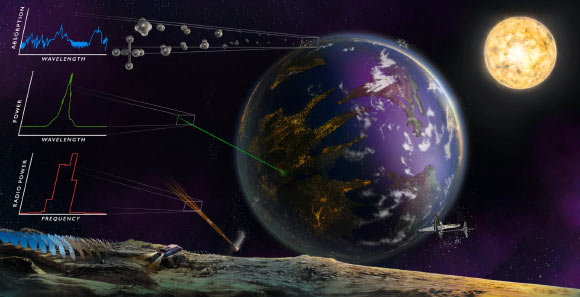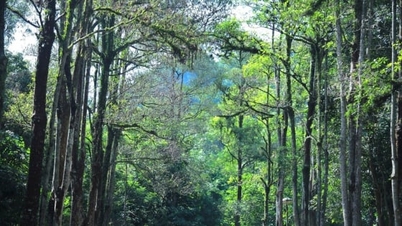(NLĐO) - Astrobiologists from the University of California (USA) have found a way to "reach" extraterrestrial civilizations.
A research team led by Dr. Edward Schwieterman from the University of California has identified five easily recognizable and accurate signs to determine whether a planet has a civilization using available means.
According to Sci-New, those five distinctive markers are five groups of greenhouse gases: fluorinated versions of methane, ethane, and propane, along with gases made from nitrogen and fluorine or sulfur and fluorine.

Illustrative image of various technological signs we might look for on another planet, including an artificial atmosphere - Photo: UNIVERSITY OF CALIFORNIA AT RIVERSIDE
Dr. Schwieterman stated that the most important thing is that these five gas groups cannot exist in large quantities in nature. Therefore, if they exist at levels that humans can detect through advanced observational tools, they must have been created by extraterrestrial beings.
The research team called the five gas groups mentioned above "technological markers".
The five gases proposed by the authors are used on Earth in industrial applications such as the production of computer chips.
Furthermore, if that civilization is more advanced than ours, they could utilize these very "deadly" things to improve the global environment.
"They would be good for a civilization to prevent an impending ice age or to terraform an uninhabitable planet in their star system, as humans have proposed with Mars," said Dr. Schwieterman.
For example, we have a frozen, arid planet with no liquid water – one of the essential conditions for life.
We could pump in more sulfur hexafluoride, which has the potential to heat the planet 23,500 times more effectively than carbon dioxide, making it warm enough for the ice and snow to partially melt into liquid water.
Another advantage of the proposed gases is their very long shelf life. Under Earth's conditions, they could be stored for up to 50,000 years.
Whether aliens accidentally created these greenhouse gas clusters through environmentally damaging industries or attempted to exploit them, it would be a sign that they are there.
More importantly, traces of these five greenhouse gas groups are easily detectable in the spectrum with the "all-seeing eye" of the James Webb telescope, even if only in small amounts.
Some of the more advanced space observation vehicles that space agencies will launch in the future will, of course, be capable of detecting them.
The results, recently published in the scientific journal Astrophysical Journal, offer an intriguing filter ready to be applied to re-examine the more than 5,500 exoplanets that humanity already knows about.
Most of these exoplanets were discovered by NASA's TESS satellite, and many of them are quite similar to Earth, meaning they have a high chance of harboring life.
Source: https://nld.com.vn/xac-dinh-5-dau-hieu-cua-hanh-tinh-co-su-song-cao-cap-196240627100116581.htm



![[Photo] Prime Minister Pham Minh Chinh attends the Conference on the Implementation of Tasks for 2026 of the Industry and Trade Sector](/_next/image?url=https%3A%2F%2Fvphoto.vietnam.vn%2Fthumb%2F1200x675%2Fvietnam%2Fresource%2FIMAGE%2F2025%2F12%2F19%2F1766159500458_ndo_br_shared31-jpg.webp&w=3840&q=75)




















![[INFOGRAPHIC] Legion Go Gen 2 sets a new standard for gaming.](https://vphoto.vietnam.vn/thumb/402x226/vietnam/resource/IMAGE/2025/12/19/1766146888809_info-taycamgames-02-jpg.webp)





















































































Comment (0)